
Cognitive Enhancing Activity of Lysimachia christinae Extract on Scopolamine-induced Memory Impairment in Mice
Abstract
Alzheimer’s disease (AD) is characterized by the gradual loss of memory and learning abilities, representing a form of dementia. Lysimachia christinae (LC), a traditional medicinal plant native to China, Japan, and Korea, is esteemed for its reputed cholagogic, hepatoprotective, and antihyperlipidemic properties. Previous research from our team has demonstrated the neuroprotective effects of LC extract in HT22 cells exposed to glutamate insult. This study seeks to further explore LC’s potential in enhancing cognitive function, utilizing a mouse model with scopolamine-induced memory impairment. The Morris water maze test assessed spatial memory enhancement, while the passive avoidance test evaluated its effect on learning memory. LC was extracted using methanol and an ultrasonic extraction device. Subsequently, the LC extract was administered to ICR mice subjected to scopolamine insult at concentrations of 100, 200, and 300 mg/kg, respectively. Notably, the LC extract significantly improved memory impairment induced by scopolamine and inhibited acetylcholinesterase activity. These results suggest that the LC extract ameliorated memory impairment by enhancing the acetylcholine esterase signaling pathway. Based on these findings, we propose that the LC extract shows promise as a potential candidate for the development of new nutraceuticals aimed at improving memory impairment.
Keywords:
Lysimachia christinae, Alzheimer’s disease, Cognitive enhancing activity, AcetylcholinesteraseIntroduction
Dementia arises from various factors and encompasses a range of cognitive dysfunctions, such as impaired learning, reasoning, and language abilities, resulting from generalized cerebral dysfunction.1 Alzheimer’s disease (AD) accounts for 50 to 60% of dementia cases, characterized by the formation of amyloid-beta plaques, hyperphosphorylation of tau protein leading to neurofibrillary tangles, and neuronal cell death due to stress.2–4 However, due to the lack of a clear etiology for AD, effective treatment remains challenging. In the early stages of AD, symptoms are subtle and difficult to discern, but as the disease progresses, neuronal damage in multiple brain regions results in significant impairment of daily functioning. Drugs commonly employed in Alzheimer’s disease (AD) treatment comprise donepezil, rivastigmine, and galantamine.5–8 The imperative to develop safe and efficacious medications for AD treatment is pressing. The Morris water maze test (MWM) serves as a behavioral assessment tool to gauge spatial memory and learning function.9 The passive avoidance test is utilized to evaluate either short-term or long-term memory.10
Lysimachia christinae Hance thrives naturally in temperate climates and is readily abundant in various regions of China.11,12 Historically, L. christinae has been utilized in Chinese traditional medicine to alleviate cholecystitis and exhibit cholagogic effects.13 Recent scientific studies have corroborated its diuretic, hepatoprotective, and anti-hyperlipidemic properties.14–16 Additionally, it has demonstrated antioxidant and anti-inflammatory activities.17,18 Moreover, scientific research has highlighted the presence of various bioactive components in L. christinae, such as flavonoids, triterpenoids, and glucopyranosides.19
In a previous study, it was found that extracts of L. christinae showed significant efficacy in protecting neuronal cells against glutamate-induced damage. Treatment with L. christinae extract reduced levels of reactive oxygen species (ROS) and calcium ions, and maintained mitochondrial membrane potential at normal levels. Additionally, L. christinae treatment led to a significant increase in glutathione content and the activities of related enzymes such as glutathione reductase and glutathione peroxidase.20
In this study, we aimed to assess the cognitive-enhancing effects of the L. christinae extract in mice with scopolamine-induced memory impairment, utilizing the Morris water maze and passive avoidance tests. Additionally, we sought to elucidate the mechanisms of action by conducting acetylcholinesterase activity assays in the hippocampus of mice.
Experimental
Plant materials and preparation – The dried whole plants of L. christinae were purchased from Chunjigayakcho, a medicinal herb market located in Seoul, Korea and authenticated by Dr. Yongsoo Kwon, a professor of the college of Pharmacy, Kangwon National University (Chuncheon, Korea). Using the ultrasonication assisted extract method, 6.0 kg of L. christinae was extracted three times with 80% methanol for 90 minutes each time. The residual solvent from the extraction was evaporated using a rotary decompressed evaporator. A voucher specimen, named CJ156M, has been archived in the natural product laboratory at Kangwon National University in Chuncheon, Korea.
Reagents – Scopolamine, with a purity exceeding 98%, along with phosphate-buffered saline (PBS) and carboxymethyl cellulose (CMC), were sourced from Sigma (St. Louis, MO, USA). Scopolamine was employed to induce Alzheimer’s-type dementia by increasing the activity of acetylcholinesterase (Ebert and Kirch, 1998). Donepezil, boasting a purity surpassing 95%, was manufactured by Samjin Pharmaceutical Co., Ltd. (Seoul, Korea). Donepezil prevents the degradation of acetylcholine by acetylcholinesterase, thereby maintaining a high concentration of acetylcholine in neuronal cells. Consequently, donepezil typically aids in enhancing memory and cognitive function.21
Experimental animals – In this study, ICR mice were utilized to assess cognitive enhancement activity. Four-week-old male ICR mice weighing approximately 25 g were procured from Kangwon Life Science Co. (Gangwon Province, Korea). These mice underwent a one-week adaptation period at the Kangwon National University Animal Care Center. Throughout the adaptation period, the animal room maintained constant conditions of temperature (23±1°C), humidity (60%), and a 12 hour light-dark cycle. Experimental animals had ad libitum access to feed and water during this period. All animal experiments and care procedures adhered to the Kangwon National University Animal Care and Use Guidelines (IACUC, KIACUC, 06/2021), and the experiment followed the ARRIVE guidelines.
Drug administration – The mice were divided into six groups (n=7): control, scopolamine, positive control (treated with donepezil at 1 mg/kg), and L. christinae groups (treated with 100, 200, and 300 mg/kg of L. christinae). The dosage of L. christinae extract for the in vivo assay was determined based on data from the in vitro cellular assay, considering future clinical trial applications. Throughout the experiments, no mice experienced toxicity-related fatalities. While a specific toxicity test for L. christinae extract was not conducted, organ examinations, including liver and heart, were performed after the in vivo assay, revealing no differences or abnormalities compared to the control group. L. christinae extract and donepezil were administered orally to mice 90 minutes before scopolamine treatment to evaluate their preventive and therapeutic effects more efficiently. The control group received only a 0.5% CMC solution. Scopolamine (1 mg/kg) dissolved in normal saline was administered to all groups except the controls via subcutaneous injection into the brain region 30 minutes before the behavioral tests. The mice underwent treatment for four consecutive days before daily trials in the Morris water maze test, while they received treatment for only one day (during the training trial) in the passive avoidance test.
Morris water maze test – The water maze test was conducted following Morris method with some adaptations. A large round pool measuring 90 cm in diameter and 40 cm in height was used, filled with warm water (20±1°C) and 500 ml of white milk. The test area was divided into four quadrants, with an escape platform placed in the center of one quadrant, positioned 1 cm beneath the water surface. The escape platform resembled a cylinder, measuring 10 cm in diameter and 26 cm in height. A smart video-tracking system (Smart ver. 2.5.21) linked to a video camera monitored and recorded all swimming activities of the mice, including swimming time, distance, and speed. When a mouse successfully mounted and remained on the platform, the time was recorded as the escape latency. Mice underwent a 60 seconds practice session without the platform on the first day as an acquisition trial. Test trials were conducted daily for four days. If a mouse failed to locate the platform within 120 seconds, the trial session was terminated, and the escape latency was recorded as 120 seconds. Following the experiment, the mice were euthanized via cervical dislocation.
Passive avoidance test – The passive avoidance test was conducted following our previous study with some adjustments. The apparatus consisted of two equally sized rooms (17 cm×12 cm×10 cm) with an electrical grid floor, connected by a guillotine door. The test comprised three distinct trials: an acquisition trial, a training trial, and a test trial. During the acquisition trial, mice were initially placed and allowed to explore the light room. After 40 seconds, the automatic guillotine door connecting the two rooms was opened. Upon entry into the dark room, the door closed automatically. Twenty-four hours after the acquisition trial, the training trial commenced. Mice were placed in the light room, and the guillotine door opened 30 seconds later. Upon entry into the dark room, the door closed automatically, and the mice received a brief electrical shock to their feet (0.1 mA/10 g body weight for 2 seconds). Twenty-four hours after the training trial, the test trial was conducted. Each mouse used in the training trial was placed in the light room again, and the latency time to enter the dark room was recorded for up to 180 seconds. Following the experiment, the mice were euthanized via cervical dislocation.
Acetylcholinesterase (AChE) inhibition assay – An AChE inhibition assay was conducted following the method of Ellman with slight modifications. Within 30 minutes after completion of either the water maze test or the passive avoidance test, brain tissue was promptly extracted from the mice. The hippocampi were isolated from the mouse brains and rapidly homogenized in sodium phosphate buffer using a Tissue Stick (Bioneer Inc., Alameda, CA, US). The reaction mixture comprised 33 μL of supernatant obtained after centrifugation of hippocampal homogenates, 470 μL of phosphate buffer (pH 8.0), 167 μL of 5,5’-dithio-bis(2-nitrobenzoic acid) (DTNB) (3 mM), and 280 μL of acetylcholine iodide (AChI) (1 mM). The inhibition of AChE enzyme activity by L. christinae extract was assessed through measurement of AChE activity using a spectrophotometer (BioTek EL808, BioTek Instruments, Winooski, VT, USA) at a wavelength of 412 nm.
Statistics – The mean±S.E.M. results from the Morris water maze, passive avoidance test, and western blot experiment were obtained, respectively. Statistical analysis of all experimental data was performed using one-way ANOVA and Tukey’s post hoc test with IBM SPSS Statistics software V26 (IBM, Armonk, NY, US). Significance levels between experimental groups were determined at p < 0.05, p < 0.01, and p < 0.001.
Results and discussion
The Morris water maze test was employed to assess the cognitive-enhancing activity of L. christinae extract against scopolamine-induced memory loss (Fig. 1). The escape latency (in seconds) of mice in the control group exhibited a significant and consistent decrease over the course of the four trial days. By the fourth day, the escape latency for the control group was recorded at 24.7 seconds. In contrast, the escape latency for mice in the scopolamine-treated group was longer than that of the control group and remained constant without improvement after the first day. On the fourth day, the escape latency for the scopolamine-treated group was 119.1 seconds, indicating effective induction of memory impairment by scopolamine in the experiment. The memory-enhancing activity of L. christinae extract was evaluated over four days, revealing a significant difference in each concentration group after the third day of the experiment. The latency time for the group treated with donepezil was 75.1 seconds on the third day, significantly reducing to approximately 52.1 seconds by the fourth day. The L. christinae extract treated groups demonstrated a dose-dependent decrease in escape latency compared to the scopolamine-treated group. At a concentration of 300 mg/kg of L. christinae extract, the latency time was 43.9 seconds. Additionally, the latency times for the 100 mg/kg and 200 mg/kg L. christinae extract treated groups were 67.3 seconds and 72.3 seconds, respectively (Fig. 1).

The effect of L. christinae extract on the spatial memory enhancement. The effect of L. christinae extract on the escape latency of scopolamine-treated mice in the Morris water maze test. The L. christinae extract (100, 200 and 300 mg/kg body weight, PO) and donepezil (1 mg/kg body weight, PO) were administered 90 min before induction of memory impairment by scopolamine. The escape latency of each group during the training-session trials is presented. Data are mean escape latencies±SD (n=6). (∗p < 0.05, ∗∗p < 0.01 and ∗∗∗p < 0.001 versus scopolamine-treated mice.)
As depicted in Fig. 2, the swimming distance covered by the control group was notably shorter compared to that of the scopolamine-treated group. Specifically, the control group swam a distance of 613 cm, while the scopolamine-treated group covered 1178 cm. The administration of L. christinae extract significantly reduced the swimming distance, which had been increased due to scopolamine-induced memory impairment, over the course of four days in a dose-dependent manner. The swimming distances for the groups treated with 100 mg/kg, 200 mg/kg, and 300 mg/kg of L. christinae extract were 1056 cm, 954 cm, and 868 cm, respectively (Fig. 2).
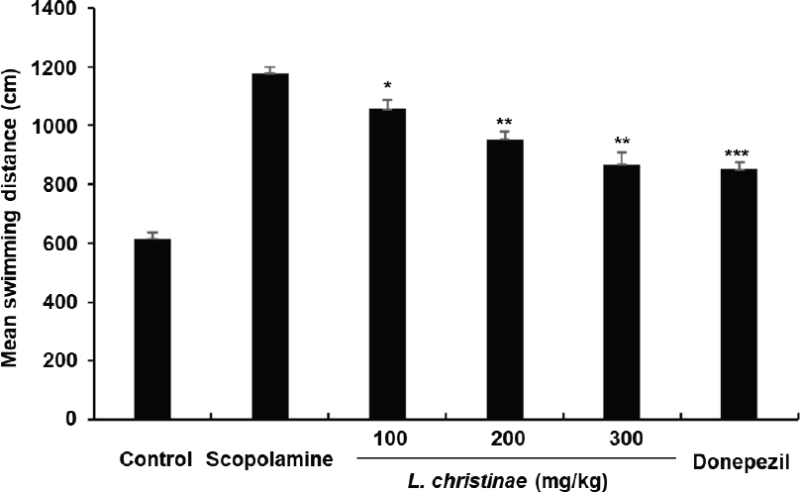
The effect of L. christinae extract on mean swimming distance to find the platform over 4 days. Data are mean escape latencies±SD (n=6). (∗p < 0.05, ∗∗p < 0.01 and ∗∗∗p < 0.001 versus scopolamine-treated mice.)
For the probe test, the duration mice remained in the target quadrant with the platform was recorded. The control group exhibited a longer stay in the target quadrant compared to the scopolamine-treated group. Specifically, the control group spent 35.8 seconds in the target quadrant, while the scopolamine-treated group spent only 11.4 seconds. Treatment with L. christinae extract led to an increase in the time spent in the target quadrant in a dose-dependent manner. The time spent in the target quadrant for the groups treated with 100 mg/kg, 200 mg/kg, and 300 mg/kg of L. christinae extract was 18.3 seconds, 21.6 seconds, and 30.1 seconds, respectively (Fig. 3).
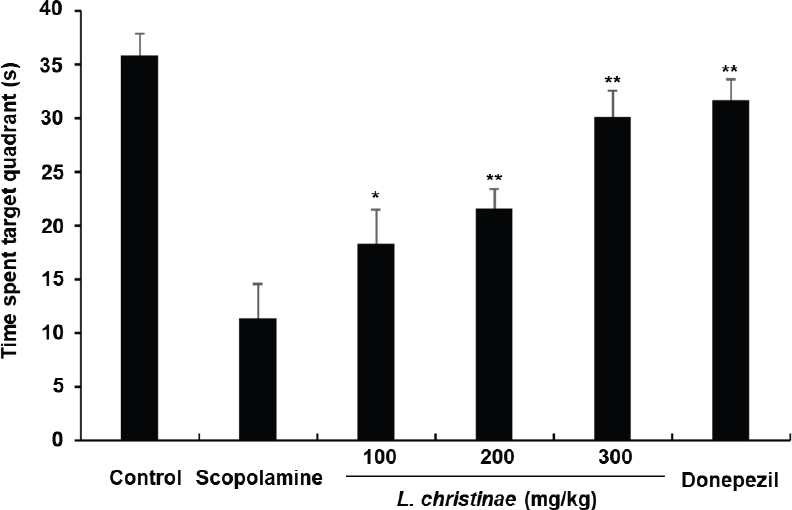
The effect of L. christinae extract in the probe trial. The time spent in the target quadrant during the probe trial was presented. Data are mean escape latencies±SD (n=6). (∗p < 0.05, ∗∗p < 0.01 and ∗∗∗p < 0.001 versus scopolamine-treated mice.)
The swimming speed of mice was assessed to verify that the reduced time to locate the target platform in the L. christinae treated group was not attributable to an enhancement in the mice’s motor capabilities. No significant differences in the mean swimming speed of mice were observed among the control, scopolamine treated, L. christinae treated, and donepezil treated groups (Fig. 4). These findings suggest that the effects of scopolamine, donepezil, and L. christinae extract were not linked to improvements in the mice's locomotor activity, but rather to the enhancement of spatial memory.
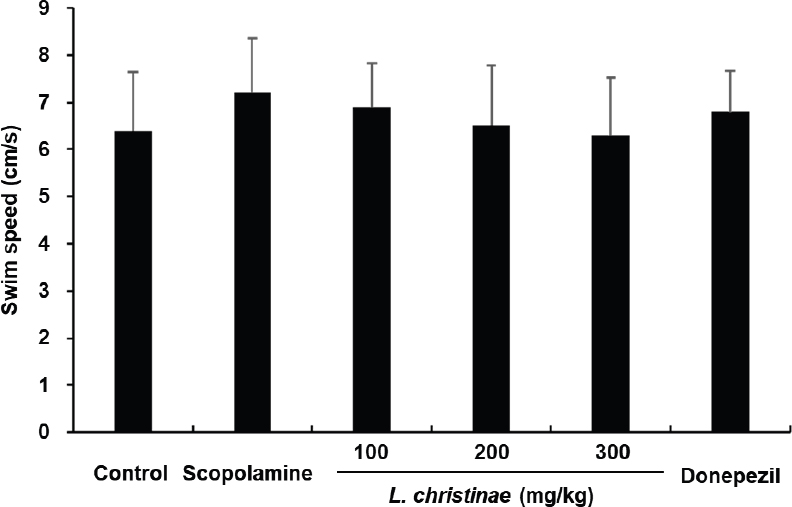
The effect of L. christinae extract on swim speed to find the platform over 4 days. Data are mean escape latencies±SD (n=6). (∗p < 0.05, ∗∗p < 0.01 and ∗∗∗p < 0.001 versus scopolamine-treated mice.)
The protective effect of L. christinae extract against scopolamine-induced cognitive impairment was assessed using the Morris water maze test, which is designed to evaluate spatial memory and learning skills.22 Scopolamine is known to inhibit cholinergic signaling, leading to deficits in learning and memory, with reports indicating an increase in AChE activity in the hippocampus of mice.23 In the Morris water maze test, L. christinae extract reduced the escape latency induced by scopolamine treatment in a dose-dependent manner, with the extract-treated group finding a shorter path to reach the platform compared to the scopolamine-treated group. Importantly, the average swimming speed of mice did not differ significantly among all groups over the four-day period, confirming that the decrease in escape latency in the L. christinae treated group was not due to enhanced motor function but rather to the restoration of memory impairment. Furthermore, the observation that the L. christinae extract treated group spent more time in the target quadrant containing the platform compared to the scopolamine treated group suggests that mice treated with the extract remembered and recognized the location of the platform. In conclusion, the results demonstrate that L. christinae extract improves spatial memory and learning ability in the Morris water maze test.
Passive avoidance test is commonly employed to assess long-term potentiation. To validate the enduring memory enhancement resulting from L. christinae extract treatment, a passive avoidance experiment was conducted using a mouse model with scopolamine-induced memory impairment. During the acquisition trial, there were no significant differences in latency time across all groups (Fig. 5). The control, scopolamine-treated, and donepezil-treated groups exhibited average latency times of 1.02 s, 1.84 s, and 1.44 s, respectively. Meanwhile, the group treated with L. christinae extract showed average latency times of 1.18 s, 1.05 s, and 1.40 s at concentrations of 100 mg/kg, 200 mg/kg, and 300 mg/kg, respectively. These results indicate that the experiment began on a level playing field across all groups.
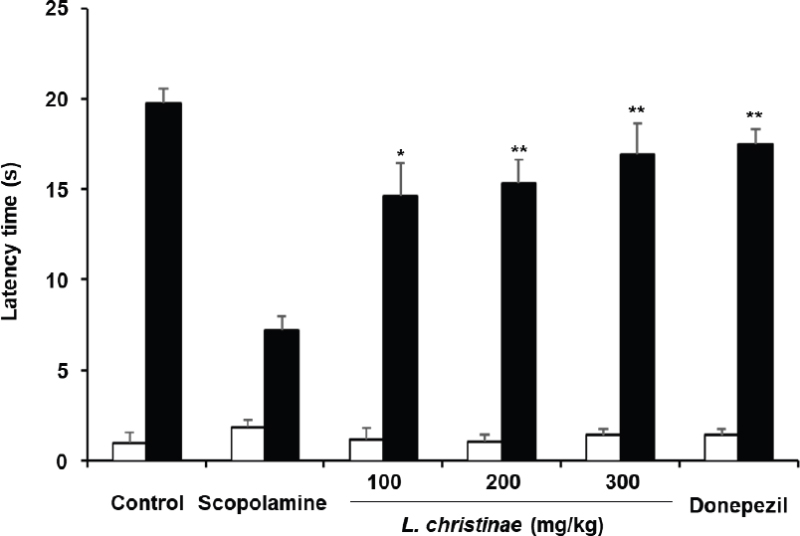
The effect of L. christinae extract on scopolamine-induced memory impairment in the passive avoidance test. The latency prior to entry to the dark compartment was recorded. Data are mean latency times (s)±SD (n=6). (∗p < 0.05, ∗∗p < 0.01 and ∗∗∗p < 0.001 compared with the scopolamine treated group).
However, the latency time of the scopolamine-treated group significantly decreased compared to the control group during the test trial, confirming the effective induction of memory impairment in mice by scopolamine. In the test trial, the control group exhibited a latency time of 19.76 s, while the scopolamine-treated group showed a latency time of approximately 7.23 s. Conversely, the L. christinae extract treated group demonstrated increased average latency times of 14.66 s, 15.32 s, and 16.98 s at concentrations of 100 mg/kg, 200 mg/kg, and 300 mg/kg, respectively.
The passive avoidance test involves animals learning to avoid aversive stimuli, such as an electric foot shock. L. christinae extract was administered orally, and the passive avoidance test was conducted to assess its potential to ameliorate scopolamine-induced memory deficits and enhance long-term potentiation. During the acquisition trial, no significant differences were observed among all groups, indicating that the experimental mice were in similar conditions. However, the L. christinae extract increased mean latency time in a dose-dependent manner compared to the scopolamine treated group. These findings suggest that L. christinae extract effectively enhances learning ability and restores memory impairment induced by scopolamine treatment.
The inhibitory effect of L. christinae extract on AChE activity in the hippocampus was assessed. AChE activity was elevated in the scopolamine treated group compared to the control group, whereas L. christinae extract significantly suppressed AChE activity in a dose-dependent manner (p < 0.05) (Fig. 6). AChE activity in the scopolamine treated group increased to 176.7% compared to the control group, while the L. christinae extract treated group exhibited reductions in AChE activity by 134.8%, 125.2%, and 113.1% at concentrations of 100 mg/kg, 200 mg/kg, and 300 mg/kg, respectively.
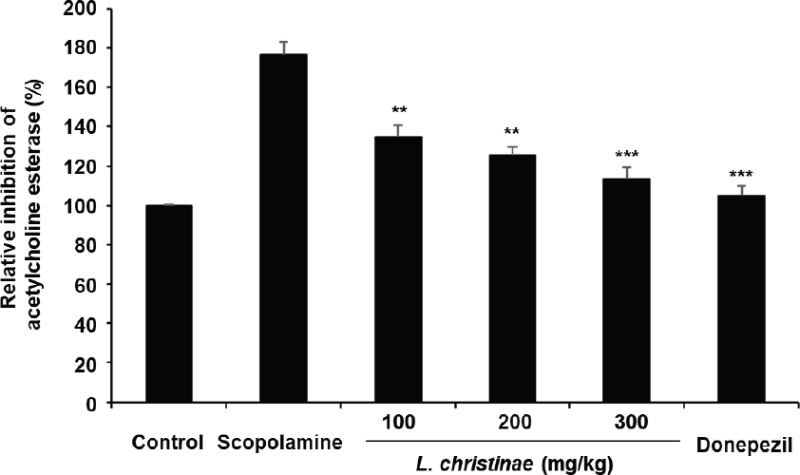
The effect of L. christinae extract on activity of acetylcholine esterase in the hippocampi of the mice. Data were means±SD. ∗p< 0.05, ∗∗p < 0.01 and ∗∗∗p< 0.001 compared with the scopolamine-treated group (n=3).
Enzyme expressions and activities were scrutinized to understand how L. christinae extract improves memory. Acetylcholine, pivotal for learning and memory, influences both working memory and spatial memory. In neurodegenerative diseases like Alzheimer’s, acetylcholine levels are often diminished, contributing to memory decline. Studies have shown that increased activation and expression of AChE reduce acetylcholine levels in Alzheimer’s patients.24,25 Consequently, AChE has become a prime target for Alzheimer’s treatment. Several inhibitors, such as donepezil, galantamine, and tacrine, have been developed to counter memory impairment by preventing acetylcholine breakdown.26,27 In AChE assays, L. christinae extract exhibited dose-dependent inhibition of AChE activity. These results suggest that L. christinae extract ameliorates scopolamine-induced memory deficits by inhibiting AChE activity, thereby augmenting acetylcholine levels.
In conclusion, our findings demonstrate that L. christinae extract can alleviate scopolamine-induced memory impairments in mice in a dose-dependent manner, likely through acetylcholinesterase inhibition. This study indicates that L. christinae extract may serve as a promising botanical drug candidate for preventing and/or treating neurodegenerative diseases like Alzheimer’s. However, the specific compounds responsible for enhancing the cognitive function of L. christinae extract remain unidentified. Further research into these active compounds is warranted.
Acknowledgments
This research was supported by Korea Basice Science Institute (National research Facilities and Equipment Center) grant funded by the Ministry of Education (grant No. 2022R1A6C101A739)
Conflict of interest statement
The authors have declared that there are no conflicts of interest.
References
-
Crapper, D. R.; DeBoni, U. Can. Psychiatr. Assoc. J. 1978, 23, 229–233.
[https://doi.org/10.1177/070674377802300406]

-
Sadigh-Eteghad, S.; Sabermarouf, B.; Majdi, A.; Talebi, M.; Farhoudi, M.; Mahmoudi, J. Med. Princ. Pract. 2015, 24, 1–10.
[https://doi.org/10.1159/000369101]

-
Esch, F. S.; Keim, P. S.; Beattie, E. C.; Blacher, R. W.; Culwell, A. R.; Oltersdorf, T.; McClure, D.; Ward, P. J. Science 1990, 248, 1122–1124.
[https://doi.org/10.1126/science.2111583]

-
Palop, J. J.; Mucke, L. Nat. Neurosci. 2010, 13, 812–818.
[https://doi.org/10.1038/nn.2583]

-
Coyle, J. T.; Price, D. L.; Delong, M. R. Science 1983, 219, 1184–1190.
[https://doi.org/10.1126/science.6338589]

-
Melo, J. B.; Agostinho, P.; Oliveira, C. R. Neurosci. Res. 2003, 45, 117–127.
[https://doi.org/10.1016/S0168-0102(02)00201-8]

-
Weon, J. B.; Yun, B.-R.; Lee, J.; Eom, M. R.; Kim, J. S.; Lee, H. Y.; Park, D.-S.; Chung, H.-C.; Chung, J. Y.; Ma, C. J. Evid. Based Complement. Alternat. Med. 2013, 2013, 1–7.
[https://doi.org/10.1155/2013/464576]

-
Ballard, C. G. Eur. Neurol. 2002, 47, 64–70.
[https://doi.org/10.1159/000047952]

-
Vorhees, C. V.; Williams, M. T. Nat. Protoc. 2006, 1, 848–858.
[https://doi.org/10.1038/nprot.2006.116]

-
Calhoun, W. H.; Smith, A. A. Psychopharmacologia. 1968, 13, 201–209.
[https://doi.org/10.1007/BF00401400]

-
Houghton, P. J.; Hylands, P. J.; Mensah, A. Y.; Hensel, A.; Deters, A. M. J. Ethnopharmacol. 2005, 100, 100–107.
[https://doi.org/10.1016/j.jep.2005.07.001]

-
Verpoorte, R.; Choi, Y. H.; Kim, H. K. J. Ethnopharmacol. 2005, 100, 53–56.
[https://doi.org/10.1016/j.jep.2005.05.033]

-
Yeh, T.-H.; Krauland, L.; Singh, V.; Zou, B.; Devarai, P.; Stolz, D. B.; Franks, J.; Monga, S. P. S.; Sasatomi, E.; Behari, J. Hepatology. 2010, 52, 1410–1419.
[https://doi.org/10.1002/hep.23801]

-
Zhang, Z.-J.; Xia, Z.-Y.; Wang, J.-M.; Song, X.-T.; Wei, J.-F.; Kang, W.-Y. Molecules 2016, 21, 738.
[https://doi.org/10.3390/molecules21060738]

-
Yang, X.; Wang, B.-C.; Zhang, X.; Liu, W.-Q.; Qian, J.-Z.; Li, W.; Deng, J.; Singh, G. K.; Su, H. J. Ethnopharmacol. 2011, 137, 57–63.
[https://doi.org/10.1016/j.jep.2011.04.029]

-
Kim, M. S.; Kim, K. O.; Kim, K. S.; Park, S. Y.; Yang, S. J.; Wei, T. S.; Choi, C. W. Herbal Form. Sci. 2015, 23, 91–99.
[https://doi.org/10.14374/HFS.2015.23.1.091]

-
Zhang, F.-S.; Liu, X.-F.; Ke, Z.-Q.; Wu, N.-H.; Chen, H.-G.; Liu, C. Pharmacology 2019, 104, 36–42.
[https://doi.org/10.1159/000500011]

- Wang, J.; Zhang, Y.; Zhang, Y.; Cui, Y.; Liu, J.; Zhang, B. Biosci. Trends 2012, 6, 89–97.
-
Ryu, G.; Ma, C. J. Nat. Prod. Sci. 2023, 29, 10–16.
[https://doi.org/10.20307/nps.2023.29.1.10]

-
Guo, J.; Wang, Z.; Liu, R.; Huang, Y.; Zhang, N.; Zhang, R. Brain Behav. 2020, 10, e01831.
[https://doi.org/10.1002/brb3.1831]

-
Pohanka, M.; Jun, D.; Kuca, K. J. Enzyme Inhib. Med. Chem. 2008, 23, 781–784.
[https://doi.org/10.1080/14756360701811023]

-
Morris, R. J. Neurosci. Methods 1984, 11, 47–60.
[https://doi.org/10.1016/0165-0270(84)90007-4]

-
Stachenfeld, K. L.; Botvinick, M. M.; Gershman, S. J. Nat. Neurosci. 2017, 20, 1643–1653.
[https://doi.org/10.1038/nn.4650]

-
Lewis, P. R.; Shute, C. C.; Silver, A. J. Physiol. 1967, 191, 215–224.
[https://doi.org/10.1113/jphysiol.1967.sp008246]

-
Blokland, A. Brain Res. Brain Res. Rev. 1995, 21, 285–300.
[https://doi.org/10.1016/0165-0173(95)00016-X]

-
McGleenon, B. M.; Dynan, K. B.; Passmore, A. P. Br. J. Clin. Pharmacol. 1999, 48, 471–480.
[https://doi.org/10.1046/j.1365-2125.1999.00026.x]

-
Ballard, C. G. Eur. J. Neurol. 2002, 47, 64–70.
[https://doi.org/10.1159/000047952]
